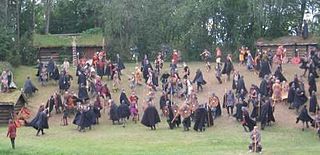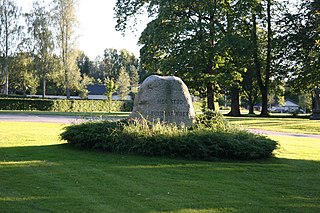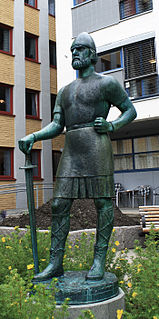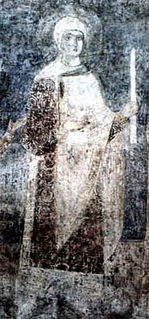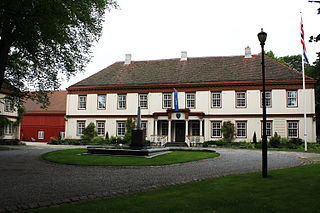Øreting (Øretinget, Øyrating; Old Norse : Eyraþing), was a Thing in Trøndelag, Norway. . Øreting was located at Øra, where the river Nidelva mouths into the Trondheimsfjord in the modern city of Trondheim. [1]

A thing was the governing assembly of an early Germanic society, made up of the free people of the community presided over by lawspeakers. The word appears in Old Norse, Old English, and modern Icelandic as þing, in Middle English, Old Saxon, Old Dutch, and Old Frisian as thing, in German as Ding, and in modern Norwegian, Danish, Swedish, Faroese, Gutnish, and Norn as ting, all from a reconstructed Proto-Germanic neuter *þingą; the word is the same as the more common English word thing, both having at their heart the basic meaning of "an assemblage, a coming together of parts"—in the one case, an "assembly" or "meeting", in the other, an "entity", "object", or "thing". The meeting-place of a thing was called a "thingstead" or "thingstow".
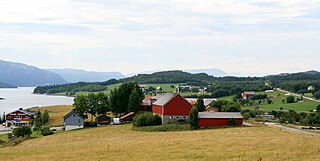
Trøndelag is a county in the central part of Norway. It was created in 1687, then named Trondhjem County ; in 1804 the county was split into Nord-Trøndelag and Sør-Trøndelag, and the counties were reunited in 2018. Trøndelag county and the neighboring Møre og Romsdal county together form what is known as Central Norway.
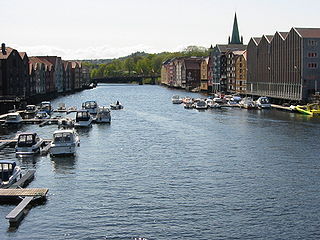
Nidelva is a river in Trøndelag county, Norway. The 30-kilometre (19 mi) long river travels through the municipalities of Trondheim and Klæbu. The name translates to the "River Nid" since the suffix elva or elven is the Norwegian word for "river".
Things were representative assemblies at which delegates from the various districts in each region met to award legal judgments and pass laws. Øreting was a common assembly for eight provinces in Trøndelag, and developed into an assembly where the King of Norway was proclaimed. Hailing of a new king, (Norwegian : Hylling), was an ancient Norse custom. Snorri Sturluson mentions in his sagas that Harald Fairhair, the first King of Norway, was hailed at the Øreting assembly. His son Haakon the Good was hailed King of the realm at the assembly in 935. [2] [3]
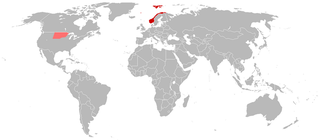
Norwegian is a North Germanic language spoken mainly in Norway, where it is the official language. Along with Swedish and Danish, Norwegian forms a dialect continuum of more or less mutually intelligible local and regional varieties, and some Norwegian and Swedish dialects, in particular, are very close. These Scandinavian languages, together with Faroese and Icelandic as well as some extinct languages, constitute the North Germanic languages. Faroese and Icelandic are hardly mutually intelligible with Norwegian in their spoken form because continental Scandinavian has diverged from them. While the two Germanic languages with the greatest numbers of speakers, English and German, have close similarities with Norwegian, neither is mutually intelligible with it. Norwegian is a descendant of Old Norse, the common language of the Germanic peoples living in Scandinavia during the Viking Era.

Snorri Sturluson was an Icelandic historian, poet, and politician. He was elected twice as lawspeaker to the Icelandic parliament, the Althing. He was the author of the Prose Edda or Younger Edda, which consists of Gylfaginning, a narrative of Norse mythology, the Skáldskaparmál, a book of poetic language, and the Háttatal, a list of verse forms. He was also the author of the Heimskringla, a history of the Norwegian kings that begins with legendary material in Ynglinga saga and moves through to early medieval Scandinavian history. For stylistic and methodological reasons, Snorri is often taken to be the author of Egil's saga.

Harald Fairhair is portrayed by medieval Icelandic historians as the first King of Norway. According to traditions current in Norway and Iceland in the twelfth and thirteenth centuries, he reigned from c. 872 to 930. Supposedly, two of his sons, Eric Bloodaxe and Haakon the Good, succeeded Harald to become kings after his death.


